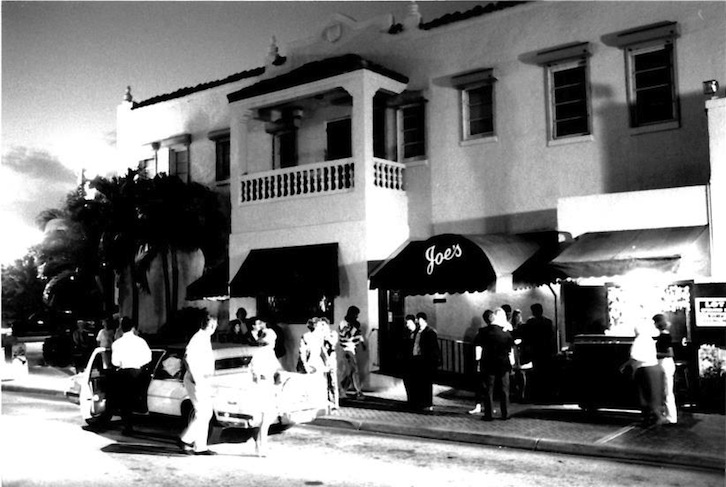Some restaurants have such protocol that, for the uninitiated, the whole experience might be off-putting and overwhelming. Joe’s Stone Crab has a reputation. By now, most everyone in the Western world knows about the sweet stone crabs of Joe’s – and they probably also know about the lines to get in, the sometimes-interminable wait, and the nagging question about whether or not to glad-hand the maitre d’. Some nights it seems the Jacksons and the Grants pass so quickly from hand to hand – and other nights, tipping beforehand appears almost non-existent. Sometimes the maitre d’ says, “There’s nothing I can do for you now. Catch me on the way out.”
So we wait. We wait in the dark-wooded bar area, a more recent addition to the Joe’s of yore, a bar that is nearly void of personality, save for its resemblance to a Hilton hotel in Kansas City, a basketball game playing on the television mounted near the coffered ceiling. And we think about why we’re waiting. Since 1913, Joe’s Stone Crab has been a mainstay of Miami Beach – and for many people, perhaps the only reason to come down to the extreme south end of the Beach. Initially a Mr.-and-Mrs. fish restaurant with six tables on the front porch of a bungalow, it wasn’t until the Twenties when a Harvard ichthyologist brought around a burlap sack of stone crabs that the nearly hundred-year-old reputation of Joe’s Stone Crab was signed, sealed, and delivered.
Found in the warm waters of the Gulf, stone crabs can only be landed with a special state permit, and only one claw harvested – whereupon the crab is thrown back into the ocean so that the claw can regenerate (which takes anywhere from 12 to 24 months). And at Joe’s, no matter how good everything else is, it’s all about the stone crabs.
And when after maybe thirty minutes, or possibly ninety, we hear our name called over the intercom, we can hardly keep from racing back to the maitre d’s station – to await our entrance into the main dining room. For this is the heart of Joe’s Stone Crab: a room imbued with the energy of all those who have come before us, the famous and the not-so, the celebrities and the big-shots, the notorious and the legendary.
For years, Al Capone dined at Joe’s, registering as Al Brown. And one night, we watched as William Jefferson Clinton presided over a table just around the corner from ours, and another night, it was Matt Damon with entourage, and there was also the evening that Larry Flynt rolled in – all characters in keeping with Joe’s history of serving the high and the mighty, as well as the rest of us. And that’s one of the joys of Joe’s main dining room: as soon as you’re seated, you’re as important as anyone else.
This is a dining room with such character and run with such professionalism that you feel immediately at home. Almost instinctively, you relax and sink into the embrace of the comfortable chair and the white-clothed service – as if your body and mind know you’re in the care of someone who does care. There’s nothing fussy here, but neither is there anything less than polished. Somehow – and it must have to do with the sense of family that Joe’s encourages – you are made to feel as if you matter, regardless of your net worth or Q rating (or lack thereof). This is the kind of service so often seen in black-and-white films from the Thirties and Forties, where decorum is considered de rigueur, without being stuffy. You are dining in a room with people who enjoy eating and eating well and the staff is there to serve you and insure that your every need is met, and primarily your comfort and enjoyment. It sounds easy enough, but few establishments get it right the way that Joe’s gets it right.
And that high standard of service is exactly the same to which the food is held. Start with the fried asparagus and then order a side of the hashed browns, and maybe the fried green tomatoes (anything fried at Joe’s is fried in 100% vegetable oil, with no cholesterol), but try not to order too much. The menu is filled with temptations, the kind of simple, well-cooked food that has been a part of American cuisine for the past 75 years – but the main point of being at Joe’s is for the stone crabs. Order what the waiter/waitress suggests, contingent upon what size stone crab is available.
And then, once your order has been given, sit back and soak up the atmosphere you waited so long to be a part of again. That room, with its dark wood and uniformed staff bustling about, and the constant parade of could-bes and wannabes and true stars, and the hum of happy diners – because another thing about Joe’s is that stone crabs require time and patience and focus and, therefore, conversation becomes secondary to the joy of eating that sweet meat. Suck every claw clean, and then order another plate of six or eight, if you can, if you want – because you might as well, while you’re here.
And then order the key lime pie because everyone does, or if you’ve ordered it before, then try the apple, which is crusted with brown sugar and butter. A silver pitcher of coffee invites you to lean back and sit awhile – and plot your next visit to Joe’s. Because, apart from the wait to get in, the whole experience is the sort you want to repeat – right down to the check, which is more than reasonable given all the pleasure you’ve received over the past two hours. Justly famous, Joe’s deserves to remain so for another hundred years.
LINK: Joe’s Stone Crab






